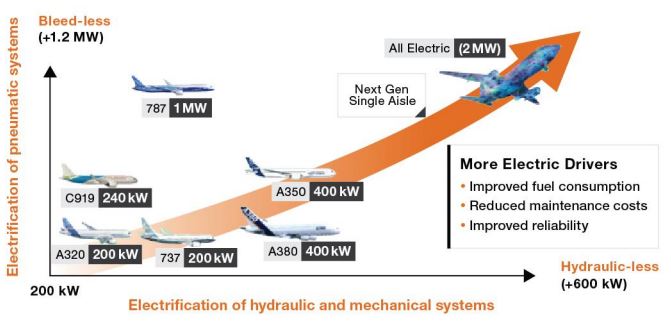United Technologies Corporation has set a bold plan in motion to use the Bombardier Dash-8 Q100 as a test-bed for their ambitious new Hybrid Electric Propulsion engine. UTC has stated that the system designated ‘Project 804’ will increase efficiency by up to 30% by operating in-place of the standard engine during takeoff. The system will be in a parallel hybrid configuration, not unlike that found in certain only automobiles. The difference being that in an automobile of this configuration, the gas-powered engine and the generator are connected to the transmission and when the battery is low on power, the gas engine steps in and takes over while the battery is charged. In UTC’s demonstrator, the goal is to have the electric motor and turbo-prop connected in parallel with the electric motor operating 50% of the propulsion system during takeoff for approximately 20 minutes, before returning control back to the turboprop engine for the cruise phase of the flight.

One of the
The sharp rise in electrical demand in commercial aircraft applications is another area of focus for Project 804 engineers. The lithium-ion battery issues that plagued the 787 are one such example of the need for more advanced and reliable power sources. According to the Project 804 team, they will develop solutions “that approach, and sometimes even exceed, 20KW” which surpasses anything available today and would make the increased demand for electrical power much easier and far safer to attain reliably in most, if not all applications.

The following is an excerpt from UTC’s statement which can be read in its entirety by following the link at the end of this post;
“The hybrid-electric system increases the aircraft Operating Empty Weight (OEW), and the aircraft’s fuel capacity is reduced by about 50% to allow for the electrical equipment and energy storage. The remaining fuel mass, combined with the more efficient hybrid-electric system gives the re-engined aircraft a range of approximately 600 nm (as compared to the base 1000 nm range). Given that 99% of this airframe’s missions are shorter than 500 nm, and that the hybrid-electric system provides an average 30% increase in fuel economy over the missions mix, this is a tradeoff that makes both technical and economic sense.
It is important to note that this preliminary study is carried out with the assumption of a re-engine in an existing aircraft. Incorporating the proposed hybrid-electric solution in a clean sheet new design aircraft could significantly reduce the weight and range penalty by better integrating the system with the airframe structure and required secondary systems. The architecture also decouples the aircraft field and flight performance to a point that new vehicles can be optimized to bring the fuel consumption per seat mile closer to an inter-city coach than the baseline airplane for typical short haul (around 400 km) and similar maximum passenger count.
More generally speaking, UTC’s hybrid-electric system is a very competitive solution wherever the peak load is of short duration and significantly higher than the normal load. The regional turboprop case was discussed here but similar benefits are expected for category “A” helicopters, APUs and some turbofans as well.”
Project 804 consists of experts from United UTC, Pratt & Whitney Canada (PWC) and Collins Aerospace. The lions share of the work is being divided between Mirabel, Quebec in Canada (PWC), and Rockford, Illinois in the United States (Collins Aerospace). The name of the project references the straight-line distance between the Mirabel and Rockford facilities.
UTC joins a growing list of manufacturers including Boeing and Lockheed Martin in the quest to make hybrid-electric engines the norm in all facets of commercial and private aviation.
UTC’s full statement on project 804 can be read here.





Recent Comments